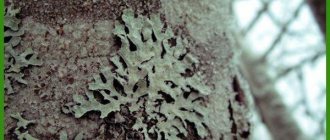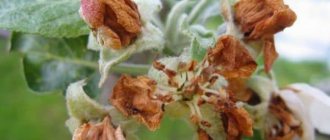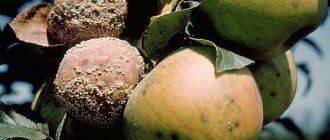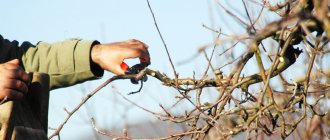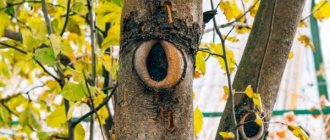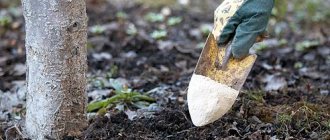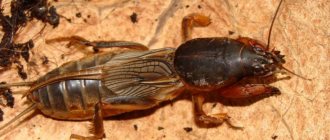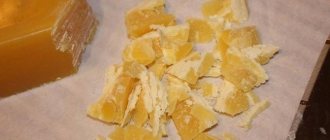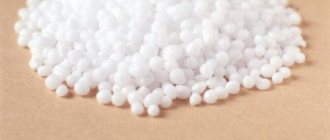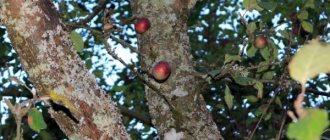Codling moth on an apple tree: methods of control
The pest spreads throughout the orchard in the form of a white butterfly, which lays eggs from which caterpillars emerge.
The caterpillar is pink or pink-red in color with grayish dots on its body. The head has a red-brown tint. During a season, a codling moth can give birth to 2-3 generations. It is the last third generation that is characterized by increased harmfulness, since the time of its appearance coincides with the beginning of crop ripening. Caterpillars overwinter in dense white cocoons.
Effective measures to combat the codling moth combine agrotechnical, mechanical, chemical and biological measures. And only the use of all of the above methods will help to quickly and effectively defeat this apple tree pest.
First of all, apple trees must be pruned in a timely manner; when can you prune an apple tree and how to do it correctly, read here. The apple tree must be provided with high-quality and timely care.
In the garden itself, it is necessary to maintain an optimal bio-balance during the process of growing the apple tree, by expanding the biological diversity of species.
Its natural enemies should be used against the pest. It is imperative to destroy the places where cocoons overwinter in the fall. Chemical treatment of trees should begin when there are at least 20-30 caterpillars on one tree. To do this, you need to use the drugs Fitoverm, Kinmiks, Karate-Zeon, Vaserktin-S. Treatment should be completed 20-25 days before the start of harvest.
When to fight against aphids?
Ants on an apple tree - how to get rid of them, harm or benefit from insects
Many gardeners ask the question of what to do against aphids on an apple tree and how to get rid of the pest in a short time. The best time for control is the early spring period before the buds open. At air temperatures from 0 to +5 degrees, eradication treatment is carried out. Then it is necessary to spray the trees before flowering to destroy the female founders of the colonies. In the future, when new generations appear, the garden needs to be processed every 2-3 weeks.
Note! To remove pests, it is important to alternate between chemical and folk remedies; it is necessary to treat the garden with them at the right time.
Preventive measures
To avoid infestation of plants with aphids, before planting you need to thoroughly inspect the planting material and seedlings.
To attract the attention of hoverflies, which destroy aphids, it is advisable to plant parsley, dill or carrots next to the beds. A good method to prevent aphids is to mulch paths with wood shavings.
An earwig lives in it, for which aphids are one of the food sources.
To avoid aphid infestation, you need to ensure that ants do not appear in the garden. If they are identified, you must immediately take all necessary measures to get rid of them as quickly as possible. To repel aphids, you can plant thyme or lavender in flower beds, the smell of which aphids cannot tolerate.
Feeding plants should be done very carefully. You should not overfeed them with fertilizers, but you should also not allow the soil to become depleted - aphids prefer weak and overfed plants. Infestation by aphids can also be prevented by timely weeding, loosening the soil, and mulching it.
Harm from green aphids to apple trees
The main damage caused by apple aphids is as follows:
- decrease in yield;
- stopping the growth of new shoots;
- the appearance of sticky liquid on tree leaves, the appearance of red spots;
- curling and drying of leaves.
Signs of defeat
Fruit trees and shrubs should be periodically inspected for the following signs of aphid infestation:
- leaves covered with sticky liquid;
- leaf curl;
- curvature of buds, petioles;
- drying of shoots.
IMPORTANT. If there is at least one of these signs, then first of all they pay attention to young shoots, leaves, and non-woody places of old branches, since this is where aphids love to settle.
How to get rid of indoor plants at home?
There are several methods to combat this dangerous pest. You can choose one or combine several, depending on the scale of the problem.
There are 2 groups of methods on how to fight and defeat aphids:
- mechanical;
- chemical.
Mechanical method
The first consists of manual pest removal. It does not require financial investments. Plants should be inspected regularly to prevent mass reproduction.
A number of conditions must be met:
- availability of time;
- patience;
- no feeling of disgust.
The method is suitable if the aphids have not yet had time to reproduce. You can collect insects by hand only at the initial stage of infection.
Chemical method
The chemical method involves the use of special products designed to kill aphids. Each of them comes with instructions with a detailed plan.
Important! The poisons are so strong that they can solve the problem the first time. Popular means for killing aphids are:
Popular means for killing aphids are:
- "Aktara";
- "Intra-vir";
- "Karate";
- "Face";
- "Hostakvik".
They contain synthetic insecticides. The preparations are suitable for treating plants indoors. The preparations need to be changed from time to time, since the aphids become immune to the chemicals.
Precautions to be taken:
- wear gloves;
- use a respirator;
- ventilate the room;
- During processing, isolate animals and family members.
The dosage of the drug and method of use are described in the instructions. Chemicals should be used as a last resort.
It is recommended to spray ornamental crops 40 days before harvest. Indoor plants are treated before the flowering phase begins.
Folk remedies
You can fight an aphid infestation using available means. They are no less effective than chemicals.
- Ammonia. The product is diluted with water (1:1) and sprayed on the plants. Repeated treatment should be carried out after 4 days.
- Soap solution. To prepare the product you will need 5 liters of water, 1 tbsp. l. ammonia, a few drops of shampoo or soap. Mix all ingredients and spray on plants.
- Onion peel. Throw a pinch of husk into a container of boiling water (1 liter) and cook for 5 minutes. Then the composition is infused for another day, filtered, and the plants are sprayed with the finished product. The product is especially effective for controlling pests on tomatoes and indoor flowers.
- Vinegar. To prepare the solution, dilute 1 tbsp in 1 liter of water. 9% acetic acid. The spraying procedure should be repeated every 4-5 days until the pest dies.
- Citrus peel. Boil orange or lemon skins. You need 1 handful per 1 liter. water. The broth is cooled, left for 3 days, then filtered. Plants are treated with the prepared product. You can simply put citrus peels in a flower pot.
- Tobacco. There are 2 ways to use tobacco. You can simply sprinkle it on the leaves and soil, or prepare an infusion. For 1 tbsp. boiling water take 1 tbsp. shag. The composition is infused for 2 days, then filtered and sprayed on the plants.
- Celandine. A glass of crushed leaves is poured into 1 liter. water. They insist and filter. The product is suitable for treating indoor and outdoor plants. If necessary, repeat the procedure after a week.
Reference! The main advantage of traditional methods is their absolute safety for animals and children.
How to deal with pests on an orchid?
There are 2 ways to destroy a pest on an orchid: chemical and folk. The latter helps solve the problem at the initial stage. It is recommended to treat the plant with soap solution, citrus peels, and onion infusion.
An effective remedy for pests is rosehip solution. The fruits (15 g) are soaked in warm water (1 liter), left for a day, then boiled for half an hour. The flowers are sprayed with the prepared solution.
After treatment, you should wait 2 weeks and observe the plant. If the insect does not die, you should resort to chemical means. The break between treatments should be 2 weeks. The same drug is not used more than 3 times.
Processing apple trees in different seasons and flowering phases
A competent farmer knows when it is best to apply the best methods to protect the garden. If the right conditions are created for plants, parasites do not have the opportunity to smolder fruits and leaves.
| Season | Types of processing |
| Spring | Using chemicals before the buds open. Treat the bark and destroy the aphid eggs. During budding, it is better to use decoctions and herbal infusions. After flowering has ended, it is recommended to use folk remedies. |
| Summer | Mechanical methods for processing apple trees. A combination of agrotechnical and biological garden protection products. |
| Autumn | Use of herbal decoctions and special infusions 2 weeks before harvest. Sanitary and preventive work in the garden. A combination of physical and chemical methods for treating apple trees. |
It is important not to miss the time to start treating apple trees for aphids, so that the population does not have time to multiply.
Types of aphids and the first warning signs of damage
Aphids are phytophagous; they pierce the plant with their proboscis, extracting juice. There are two forms of aphids: winged and wingless. Certain species of aphids find food in the root system.
Red gall midge is most often found on apple trees, as well as:
- red-headed striped;
- blood;
- green apple and plum.
Potato aphids will not disdain fruit trees either. This tenacious species is found in seedlings and on indoor plants.
16 excellent varieties of plums for the Moscow region
Attention! Tobacco aphids get from weeds to fruit trees, so it is so important to keep the area clean. Wingless forms of aphids reproduce without fertilization. In other words, all individuals are capable of producing offspring
Over the summer, up to nine generations of aphids hatch. The eggs laid by winged females hatch into larvae. At one time there are from 40 to 100 pieces. Females are able to fly 25 km, exploring new territories
In other words, all individuals are capable of producing offspring. Over the summer, up to nine generations of aphids hatch. The eggs laid by winged females hatch into larvae. At one time there are from 40 to 100 pieces. Females are able to fly 25 km, exploring new territories
Wingless forms of aphids reproduce without fertilization. In other words, all individuals are capable of producing offspring. Over the summer, up to nine generations of aphids hatch. The eggs laid by winged females hatch into larvae. At one time there are from 40 to 100 pieces. Females are able to fly 25 km, exploring new territories.
Peak insect breeding occurs in September. In late autumn, the adults die, and the eggs overwinter safely in the tree bark. In spring, the larvae feed on the first greenery, then infect the buds and buds of trees.
Red puffy spots on the leaves of an apple tree should alert the gardener. The so-called galls result from infection by a virus carried by aphids. The next stage is curled dried leaves. A well-known sign of this pest is a sticky coating (honeydew). The sugary liquid is released as insects feed and is a delicacy for ants.
Why do aphids appear on apple trees?
In mid-spring, female insects grow wings, thanks to which they can move to other plants. This annual ritual is performed to form new colonies of pests. If preventive work is not carried out to eliminate aphids, then by the end of the summer season small arthropods will be able to spread throughout the entire summer cottage. During this period, insects reproduce especially quickly. By the time autumn arrives, their main task is to create a new generation of pests.
After fertilization, the female lays eggs, which do not hatch during the winter season. After the cold weather passes, with the arrival of spring, larvae are born from them. Adults die from low temperatures. For the birth of new insects, increased humidity is required, which is observed when the snow melts.
Larvae are the greatest threat to apple trees. To create an exoskeleton, they need a large amount of nutrients, so they actively eat the plant for 2-3 weeks. The apple tree loses buds, leaves, flowers and young shoots.
After 14 days of hatching, each of the larvae turns into a female, which grows wings and migrates to a nearby apple tree or other garden tree. In their new habitat, females form their own colony of insects. Pests reproduce until the end of summer, then their life cycle repeats again.
Sometimes aphids appear because of ants. The latter are also pests of fruit crops. Ants are attracted to the honeydew produced by aphids. Insects create a symbiosis with each other. Ants protect small pests, so their colony increases. In return, the aphids produce a sweet secretion for them.
Apple trees are inhabited by red-headed and gray insects, the size of which does not exceed 2-3 mm. The aphid is distinguished by a black body and tail, and a red head. Females that reproduce on fruit plants lay up to 40 eggs at a time. The most active breeding season for aphids is at the end of August or beginning of September. They feed on apple juice to replenish potassium, phosphorus or amino acids. In rare cases, pests settle on a fruit plant due to an excess of nitrogen in the body.
Life cycle and description of melon aphid
The life cycle varies greatly between the northern and southern regions. In the north, female nymphs hatch from eggs on primary hosts in the spring. They can feed, mature and reproduce parthenogenetically (viviparous) on one host all summer, or produce winged females that disperse to secondary hosts and form new colonies. Dispersers tend to select new growth to feed on and can produce either winged (alata) or wingless (aperthese) female offspring. Under conditions of high density, when the host plant is wilting or in autumn, the production of winged forms predominates. At the end of the season, the winged females seek out primary hosts and eventually both males and females are born and lay eggs. They mate and the females lay yellow eggs. Eggs are the only hibernating form in cold conditions. In warm conditions, a generation can be completed in about seven days.
In the south, gender forms are not important. Females continue to produce offspring without mating as long as the weather allows them to feed and grow. Unlike many species of aphids, hot weather does not have a negative effect on melon aphids. Melon aphids can complete their development and reproduce in as little as a week, so that multiple generations are possible under suitable environmental conditions.
The eggs are laid yellow, but soon turn shiny black. As noted earlier, eggs are usually laid on catalpa and rose of Sharon.
Nymphs vary in color from brown to gray or green, and are often marked by a dark head. The thorax, wing pads and distal part of the abdomen are dark green. The body is dull in color and covered with waxy secretions. The nymphal period averages about seven days.
Aphids go through four molting stages before they reach maturity. At each stage they lose their white skin. Cotton aphids are easily distinguished from other aphids due to the color of their two cores (siphuncles). These cores are always black, regardless of the color of the midge, which can range from light yellow to light green or even a green-black hue. This coloration depends on temperature, host plant and insect density.
Adult wingless (aparter) parthenogenetic females are 1 to 2 mm long. The body is quite variable in color: light green with patches of bright green is most common, but whitish, yellow, pale green and dark green forms are also found. The legs are pale with black paws. The folds are also black. The small yellow forms form in response to crowding or stress on the host plant. Winged (alate) parthenogenetic females range from 1.1 to 1.7 mm in length. The head and chest are black and the belly is yellowish-green, except for the tip of the belly, which is darker. The wing veins are brown. The oviparous female is dark purple-green; the male looks like the female. The duration of the reproductive period in an adult is about 15 days, and the post-reproductive period is five days. These values vary significantly, mainly depending on temperature. The optimal temperature for reproduction is from 21 to 27 degrees. Live females (give birth to live aphids) produce a total of 70 to 80 offspring at a rate of 4.3 per day.
Signs of a pest
The main sign is the presence of individuals on the tops of young shoots, the underside of leaves, which can curl, wrinkle, curl and bubble. Features of external manifestations depend on the type of insects that have settled.
Aphids are dangerous and prolific insects
At least 4 species of aphids parasitize apple trees in the temperate zone of our country, and in total there are about 5 thousand of them in the world. Generations of pests look different; they have winged and wingless individuals.
Green apple aphid
The main parasites of apple trees:
- Green apple aphid - the female founder has a green body, the head is brown, the winged female dispersers are green with black legs and head. Their antennae are yellow and dark at the ends.
- The apple-grass aphid has a yellowish body, a dark green stripe runs along the back, which at the back turns into transverse lines of the same color. Over the summer it produces at least 5 generations, each taking about 7 days to develop. If you have a lawn of bluegrass in your garden, this type of aphid will start feeding on those grasses. It is very difficult to notice pests on the lawn externally, since they feed at the root collar of plants.
- Red gall aphids (apple gray aphids) are large individuals of dark gray color with a white coating, producing up to 5 generations per season. The leaves of apple trees curl down, become lumpy, and acquire a purplish-red or pink color. The apple may have crimson spots at the time of ripening. This species of aphid has several migratory forms and intermediate hosts in the form of weeds; they are well adapted to survive in the environment.
- Apple-plantain aphid - young larvae are pinkish in color, adults are gray-green with a white waxy coating, each is capable of producing second-generation offspring in the amount of 250 pieces. A characteristic feature is that the leaves of apple trees curl crosswise. In the second half of summer it switches to eating plantain.
- Pear-cereal aphid - individuals are red-brown in color, when crushed they leave reddish marks and are harmful on pome-bearing trees. Young shoots after colonization turn black and die. A web of mites appears on the branches, attacking weakened shoots. In July, aphids switch to feeding on cereals, including lawn grasses.
Red gall aphid
Important! The type of mouthparts of aphids is sucking. Insects puncture the tissues of young leaves and suck out the sap of the plant. At the moment of puncture, substances are injected that cause leaf curling.
How to get rid of aphids in the garden
Mechanical method
If the infestation area is small, you can collect the pests manually or wash them off with a powerful stream of water at high pressure.
Biological method
This is where the enemies of aphids that eat them can come to the rescue. These are small birds and ladybugs. Lacewings, hoverflies and even some species of wasps cope well with the pest. Moreover, the lacewing destroys aphids much more effectively than ladybugs. To attract enemies of sucking insects, it is worth planting green manure, herbs, and nettles.
Larvae of lacewings and ladybugs can be purchased at garden centers in case of large pest infestations.
It is important that these are insects adapted to live in this region
Birds (sparrows, titmice, wrens, warblers and others) destroy harmful insects well, so it is worth attracting birds to your site.
Aphids have favorite plants: poppy, nasturtium, cosmos, begonia, mallow. Plant these plants away from garden and vegetable crops. The favorite trees of aphids are viburnum and linden. You should not plant valuable garden plants next to them.
how to get rid of aphids on the site
Folk remedies
- The most common and proven remedy over the years is a mixture of laundry soap (it is better to use liquid household soap for washing dishes) and vegetable oil. This mixture adheres well to the foliage, enveloping it, and makes it difficult for insects to breathe, which leads to their death. Add 2 tsp to 2 glasses of water. liquid soap, a little vegetable oil (up to a glass) and spray the mixture in the evening through a spray bottle. Repeat the treatment until the pests are completely gone.
- Garlic infusion is successfully used in the fight against aphids. Finely chop 4-6 cloves of garlic and infuse for 3-5 days in 0.5 liters of water. Before use, add 1 tsp. liquid soap and 2 tsp. any vegetable oil. Then 2 tbsp. l. The resulting mixture is added to 5 liters of water and the infected areas are sprayed.
- An infusion of onion peels is also used. Infuse 100 g of husk in a liter of water for at least two days. Before use, add water in a 1:1 ratio and treat the affected crops.
- Tobacco infusion or any waste tobacco products are also used. In addition to aphids, tobacco also repels leaf rollers and sawflies well.
- You can infuse 100 g of any dry citrus peels (lemons, oranges, tangerines) in a liter of water for three days.
- Marigolds can also rid plantings of aphids. To do this, leave 0.5 kg of finely chopped marigolds in 1 liter of water for 2-3 days and spray the young plants.
- Treatment with infusion of potassium and phosphorus fertilizers helps. Take 5 g of any potassium fertilizer, 10 g of superphosphate and leave it in 10 liters of water for at least two days. Then the plantings are sprayed. This treatment increases the resistance of plants against pests. Repeat the treatment after 12-14 days.
Treatment with chemicals
When using chemicals, you should carefully read the instructions and prepare solutions strictly in the required proportions, observing all safety precautions. We hope that you have learned how to get rid of aphids in the garden and will always have a wonderful harvest
We hope that you have learned how to get rid of aphids in the garden and will always have a wonderful harvest.
Read how to treat diseased plants.
I invite you to the group for “Country Hobbies”
Prevention
It is better to take preventive measures and prevent aphids from breeding. After all, the struggle will require much more strength, energy, attention and investment. Plants with strong repellent odors are planted next to apple trees. These include:
- coriander;
- tomatoes;
- garlic;
- dill;
- parsley;
- marigold.
In addition to strong-smelling plants, they attract insects to the garden, for which aphids are a favorite food. These are ladybugs, hover flies, lacewings, some types of spiders, and sand wasps. To attract them, it is recommended to plant dill, oregano, marigolds, yarrow, and buckwheat.
IMPORTANT! Regular inspections of trees and young shoots before and after planting are a necessary part of prevention.
You should also monitor the ant population in the area. In autumn, it is recommended to remove old dried leaves and affected areas from trees. Once removed, they are burned.
When apple aphids appear on trees, it is necessary to take urgent measures to destroy them, since very soon all the trees in the area will be infected. The parasitic insect and its larvae will gradually suck all the juices out of the tree and destroy it.
Physical and biological means of controlling aphids
If the affected area is small, you can remove insects with a cotton swab dipped in a soap solution. Aphids are inactive and are washed off with a stream of water. Dried leaves are collected and burned. This method is used to control aphids in greenhouses and nurseries. A large apple orchard requires more extensive action.
Starlings happily peck at aphids. Make houses for these birds and they will protect your trees. The pests feed on linnets, sparrows, robins, tits, and wrens. To lure birds to your site, equip drinking bowls and feeders. Plant fragrant and berry bushes; the plants will bear fruit and attract insects. Insects that eat aphids are ladybirds, hoverflies, and lacewings.
Advice! To increase the number of ladybugs in the garden, leave an area of uncut grass. Dandelions, tansy, yarrow, dill are the favorite plants of these bugs.
Aphid colonies are protected by ants. A large number of anthills is a sure sign of the presence of a dangerous pest. It is necessary to monitor this in the area and, if necessary, destroy the ants.
Apple tree leaves affected by aphids
Aphids cannot tolerate the odors of the following insecticidal plants:
- Caucasian chamomile, calendula, marigolds, celandine, tobacco.
- Garlic, hot pepper, celery, horseradish, onion.
- Lavender, sage, basil, mustard, fennel, mint.
Herbs are planted near the plot or garden. Spraying with infusions is also effective.
Biological methods for removing aphids
Such methods involve the use of parasite enemies - birds, ladybugs, odorous plants. It is necessary to create conditions in the garden that are attractive to “helpers”:
- Plant tansy, lemon balm, garlic, and tomatoes near the apple trees.
- Place bird feeders on trees.
- Do not destroy insects that feed on aphids (lacewings, etc.).
- Remove anthills from the garden.
Sometimes it is enough to “drive” the ants away from the apple trees for the aphids to disappear.
Apple aphid: methods of control and prevention against green aphids
Small (2-3.5 mm long) sucking insects. Leaves are damaged and become wrinkled and curled. When severely damaged by aphids, the ends of the shoots become bent and stop growing. There are 2 types of aphids found on apple trees: the green apple aphid and the red gall aphid.
Green aphids are widespread and very harmful to young trees. Reproducing quickly, aphids form numerous colonies on leaves and young shoots. By sucking the juice out of them, it causes great harm, causing stunting and sometimes the death of young trees.
Red gall apple aphids mainly damage leaves. They become lumpy, dark red, with edges turned downwards; later the leaves dry out and fall off. Distributed in patches. If the infection is severe, the trees die.
Control measures
Control measures against larvae hatching from eggs during bud break and during the growing season: trees are sprayed with a 0.3% solution of karbofos; against overwintering eggs, trees are treated with a 3% solution of nitrafen in the spring before buds open.
Apple green aphid
1 - Overwintering aphid eggs on apple tree branches; 2 - Larvae on a blossoming bud; 3 - Larva; 4 - Wingless viviparous aphid, 5 - Winged disperser; 6 - Apple tree shoot damaged by green apple aphids;
The apple moth is a silver-white butterfly with a wingspan of up to 20mm. IN.
Pests of chokeberry mainly damage the vegetative part.
The codling moth is a small gray butterfly with a wingspan of up to 18.
The harmful ones are yellowish-white caterpillars with black warts in the form of something.
The larva is yellowish-green with a thickened head part, covered with black.
Red apple mite. Harmful to apple, pear, plum, cherry, rowan, and broom trees.
Caterpillars that are yellowish-white with black are harmful b.
Planting work can be carried out in autumn and spring.
Source of plant nutrition and increase fertility.
In this article we will describe in detail the form of the square's structure.
Powdery mildew, white and black spots, rust.
Why are green apple aphids harmful?
Apple aphids damage stone fruit crops. She prefers young shoots. Aphids usually hide on the undersides of leaves.
Insects feed on the sap from young shoots, which causes them to curl and darken. The lack of nutritious juices leads to slow development of shoots or their wilting.
Aphids cause the greatest harm to nurseries. If there is a strong infestation of parasites, trees that have not yet matured may die.
Apple aphid on a stem, photo
Apple aphid with ants
Apple aphid on a leaf, photo
Control measures
Peak reproduction of the insect occurs at the beginning of summer, so June is the month of pest control in many garden areas. You can destroy aphids on fruit trees using special preparations, as well as using simple folk methods. Let's take a closer look at both of these types.
Drugs
Contact
This category of chemicals affects aphids by direct contact with their body. Many gardeners choose this particular type of preparation, because of all the “chemicals” they are the most harmless. To combat aphids that have settled on garden fruit crops, it is recommended to use the following means:
- Fufanon (it will also be useful to learn about how to use fufanon against weevils on strawberries);
- Fury;
- Karbofos (it will also be useful to learn about how strawberries are treated with karbofos in the spring).
Intestinal
The effect of these drugs is based on their ingestion by aphids. Essentially, the substances poison the insect’s body from the inside, after which the aphid dies. The following drugs in this category are recommended:
- Confidor;
- Aktellik;
- Bankol.
System
These are the most effective chemicals, but they are also the most aggressive and dangerous. Systemic agents should not be used during the period of flowering, ovary formation and fruiting. It is possible only before flowering in the spring.
Note that these products are able to penetrate deeply into plant tissue and stay there for about 30 days. The result of spraying will not appear immediately, but after two weeks - you need to be patient.
The following systemic category drugs are especially effective in controlling aphids:
To prevent the appearance of aphids on fruit trees, even before new buds appear, it is recommended to spray the plants with a preparation such as C-30. This product can destroy the larvae and eggs of the pest.
Traditional methods
Products in this category are considered safe because they are prepared from natural ingredients. Therefore, homemade medicines can be used for spraying fruit crops during their flowering and fruiting period: there will be no harm.
However, compared to “chemistry”, natural remedies have lower efficiency, so they are recommended only when the aphid colony is still small. Let's find out the most commonly used recipes.
The video shows traditional methods of fighting aphids:
Tobacco processing
To fumigate trees with tobacco, you need to purchase tobacco dust. This is a natural insecticide that has a detrimental effect on aphids, as well as some other pests: moths, thrips, slugs, midges. To properly apply the substance, you need to set fire to wood chips in a metal bucket and pour tobacco dust onto the resulting flame. The dust must be directed in such a way that the wind blows it into the trees.
Infusion of celandine
It is necessary to infuse the product for at least three days until an unpleasant characteristic odor begins to emanate from it. Before spraying, dissolve 40 grams of soap in the resulting infusion and strain. It will also be useful to learn about how celandine infusion is used against aphids.
Onion peel infusion
To prepare the desired solution, you need to steep onion peels in water for two days. After this, the product is filtered and a concentrated solution of laundry soap is added to it.
Kerosene method
A solution of kerosene (70 g) and soap (35 g) in a bucket of water (10 l) can be sprayed on fruit crops, but only before the buds open. The solution effectively destroys insect larvae and eggs, not only aphids, but also other pests.
Dandelion decoction
It’s simple to prepare the product: you need to take 150 grams of dandelion leaves or stems, add a liter of water, and boil for 15 minutes. Then the product is diluted with ten liters of water and used to treat trees.
Nettle tincture
In addition, nettle infusion can be used to treat tree trunks to repel aphids.
So, we have considered measures to combat aphids that have settled on fruit trees. As you can see, this insect, despite its miniature size, poses a real danger even to huge fruit crops. It is advisable to combat aphids at the earliest stages, and even better, to carry out preventive measures in advance, preventing trees from being affected by this pest in principle.
Description and varieties
Aphids are miniature insects that feed on the leaves and fruits of various garden plants (you can read about what aphids feed on here). Usually the aphid body does not exceed 6-8 mm in length . Its coloring can have various shades (gray, black, whitish, light green, dark green, orange, etc.) and, in most cases, depends on the plant whose leaves they feed on.
Reference! According to its biological affiliation, aphids belong to the family of phytophages.
A distinctive feature of this subspecies of insects is the presence of a small proboscis, with which they destroy the upper integument of plants and absorb their pulp.
The type of aphid that attacks apple trees is classified as: gray or red-headed . The eggs of this insect are present on almost any tree. In winter, they “hide” under the bark, and with the arrival of spring warming, females hatch from them. After a few weeks, and given a favorable environment, the females establish a colony, producing thousands of similar insects.
Green apple aphids do not exceed 2 mm in length and have a different color: a greenish-gray body with a red head and white antennae. Over time, the color changes somewhat: the body noticeably turns black, and the abdomen turns green. The peak of aphid reproduction, if appropriate control is not carried out against it, occurs at the end of summer - beginning of September.
Read more about aphid species in this material.
Effective insecticides
When there is a large-scale infestation of fruit trees by aphids, ecological methods of control are no longer sufficient; in this case, chemicals are used. The most effective of them are:
- "Fitoverm";
- "Iskra Golden";
- "Cypermethrin";
- "Decis";
- "Fury";
- "Nitrafen";
- "Akarin";
- "Kinmiks";
- "Oleocuprite";
- "Intavir";
- "Karate";
- "Trichopolus";
- "Fufanon";
- "Karbofos".
Each drug should be used only in accordance with the instructions supplied by the manufacturer.
The chemicals “Dichlorvos” and “Karbofos” are recommended to be used only in cases of extreme necessity, since these substances are characterized by high toxicity.
When to start fighting
It is necessary to start destroying aphids as early as possible. It is advisable to do this immediately after detecting it:
- While the tree is flowering, aphids will attack the opening buds. As a result, the flowers will begin to fall off. And this can lead to a lack of harvest. Therefore, it is recommended to destroy aphids before flowering begins.
- If it appears in June-July, the tree must be sprayed with special compounds immediately. Otherwise, insects will cause the developing fruits to fall off.
- If you spray the tree while the fruit is ripening, the apples will have to be left on the tree for another 1-2 weeks. During this time, the insects will die and the products used for spraying will evaporate.
Therefore, it is advisable to regularly inspect trees for pests. The earlier aphids are identified, the less damage they will cause to apple trees.
Event dates
It is necessary to constantly monitor the condition of fruit trees, taking into account the fact that some types of pests have the ability to migrate. If a problem is discovered, you need to immediately begin to fix it, and ideally, do this in advance.
Treatment with pesticides should be carried out approximately a month before flowering, since the effect of the drugs, which persists for 20 days, is dangerous for insects pollinating flowers. During flowering, procedures using non-toxic products are recommended.
Before flowering
The aphids present on the trees during their flowering attack the buds that have not yet had time to open, which has a detrimental effect on the future harvest. Therefore, it is recommended to carry out insect control procedures before this period begins.
After flowering
In June–July, adult individuals may emerge from undestroyed winter eggs. In this case, you need to immediately treat the garden with any of the means: a folk (prepared yourself) insecticide or a biological product, otherwise the invasion of pests will lead to the fall of fruits that have not yet had time to form.
During fruit ripening
It is unacceptable to spray fruit trees with chemicals 20 days before harvesting. If such a need arises, it is recommended to delay collecting it for 2–3 weeks to allow the insects to die and the means used to evaporate.
Autumn procedures
After harvesting and the end of leaf fall, gardeners perform the last spraying of the current season, and also prune damaged branches, which are burned along with fallen leaves.
Processing cycles
The frequency of activities related to the elimination of aphids is determined by the phases of the growing season of apple trees, namely:
In February and March, tree buds are still dormant; at this time, procedures are aimed at destroying insects that survived the winter. In April and May, buds open and buds form, which are important to protect from damage by aphids. At the end of May and beginning of June, during fruit set, 1 to 2 treatments are performed. June and July are characterized by active ripening of fruits; spraying is performed 2–3 times, giving preference to folk and biological remedies. In August and September - the fruiting period - no more than two disinfections are allowed. October and November are the end of the growing season; at this time, the trees are being processed and prepared for winter.
Features of the fight against aphids in different regions
In each region, the formation of buds and inflorescences in trees occurs at different times, which is determined by the climatic characteristics of a particular area. For this reason, measures to destroy aphids in orchards are carried out at different times, depending on the phase of the growing season of apple trees.
Causes of aphids
How to get rid of ants on fruit trees - folk remedies
Apple and other types of aphids are endemic to Eastern Europe; many live in the southern regions of our country and Crimea. These insects quite often parasitize field cereal crops, wild apple and pear trees, from where they migrate to orchards. Aphids appear on apple trees for a number of reasons:
- spontaneous outbreak of the pest in a given area due to favorable conditions for overwintering and development of individuals in the spring;
- the presence in the garden of plants - intermediate hosts: bluegrass, fescue, wild oats, brome, wheatgrass, foxtail, currants, gooseberries, raspberries, horse sorrel;
- settlement of ants in the garden, as they feed on aphid secretions (molasses) and transfer individuals to the young growth of apple trees.
Ants can also contribute to a favorable overwintering of aphids. They take eggs and founding females into their nests for the winter, and take them out in the spring, finding the best feeding conditions for them.
Overwintering of aphids occurs in the stage of eggs, which at the end of autumn are laid by females in cracks and folds of the bark of skeletal branches and individual fruit formations. The older the tree, the easier it is for pests to overwinter on it.
How to fight aphids?
Today there are a huge number of means to combat aphids. Many people ask: How can you treat apple trees against aphids?
The most important thing in this matter is not to waste time. If you find aphids, the first spraying is best done at a time when the leaves are just beginning to emerge from the buds. The next treatment is carried out a month after the first; as a rule, this period begins in June.
Aphids are very afraid of ladybugs. If there are a lot of these insects in your garden, then there is no need to worry about aphids.
The most effective methods of controlling aphids are chemicals. They destroy the pest very quickly. Below is a list of the most effective drugs against aphids. But first, let's talk about the fight against aphids with folk remedies.
Folk remedies.
Folk remedies show themselves to be quite effective. Of course, they are inferior to chemicals, but folk remedies are absolutely harmless.
Remedy for aphids No. 1. Onions and their peels help well. To prepare the product, you need to take 200 grams of onion peels and various onion peelings. All this is poured with 10 liters of hot water and infused for 4-5 days. The apple tree is sprayed with this product 3 times with an interval of 5 days.
Folk remedy for aphids No. 2. Take one bucket of water, in which you dissolve: 200 grams of soap, one glass of tobacco broth, half a glass of wood ash and a quarter glass of kerosene. Spraying is carried out 1 time. This product helps very well to get rid of aphids on apple trees when trees are massively infested.
Folk remedy for aphids No. 3. Another folk remedy based on tobacco. Take 250 grams of tobacco and infuse it in 6 liters of water for 2-3 days. Then the resulting infusion is filtered, and another 6 liters of water are added to it. After this, half a piece of laundry soap is added. The entire product can be used in the fight against aphids.
Folk remedy for aphids No. 4. To prepare an effective pest control product, you need to mix 2 cups of ash in one bucket of water. Then add half a piece of laundry soap and mix thoroughly. Let the solution brew for 1 day. That's it, the product is ready for use.
How to treat an apple tree against aphids? Special means.
Many gardeners ask: How to treat apple trees against aphids? Today, stores have a huge selection of special products to combat this pest. Let's look at the list of the most effective and proven ones.
- Nitrophen is a very strong remedy against insect pests. This product can only be used in early spring, even before the leaves appear. Otherwise, you can simply burn it. To prepare the solution, dilute 200 grams of the product in 10 liters of water. That's it, you can start spraying.
- Insecticide Kinmiks is a universal drug that is designed to destroy all insects that suck juices from plants. This drug should be used during apple tree flowering. Detailed instructions for use can be read on the packaging.
- Karate. This product has proven itself very well among gardeners. In addition to effectiveness, the drug has another advantage - cost-effectiveness. 10 liters of solution is enough for 1 hundred square meters of trees.
Aphids on the apple tree are no longer a problem for you. You know how to deal with it and by what means.
Based on materials:
How to prevent infestation of neighboring trees
To protect the garden from the spread of aphids, it is important to carry out a set of measures:
- get rid of the pest on diseased trees in a timely manner;
- carry out eradication spraying of the entire garden, including berries (raspberries, strawberries, currants, gooseberries);
- clean the trunks of old trees from peeling bark, whiten them at the end of winter;
- ensure timely protection of lawns and vegetable beds growing nearby, especially where there is horse sorrel, from invasions of aphids and other harmful insects;
- remove shoots growing from the root and on the trunk;
- regularly weed the rows;
- apply root and foliar fertilizers for rapid growth of leaves and shoots, coarsening of tissues;
- combine chemical treatments with folk remedies.
Systematic, targeted work to protect the garden and seedling nursery will certainly bring results in the form of well-developed plants, large healthy leaves and fruits with high nutritional properties, because apples are a valuable source of vitamins all year round.
How to detect
In the initial stage, plant infestation by aphids may go unnoticed. Small single insects are detected only upon careful examination. Larvae and adults live on the underside of leaves, the upper part of young shoots, and petioles.
After a few days, the population increases; entire colonies of pale green insects can be seen on young shoots. Among the obvious signs of plant infestation with apple aphids:
- reddish and brown spots on the leaves;
- withering young shoots;
- falling buds;
- sticky streaks on leaves and petioles;
- increasing number of ants.
Chemicals
The use of insecticides and pesticides is the most effective method of controlling aphids. Harmful insects die almost immediately or within a few hours after spraying pesticides.
There are a wide variety of chemicals that can be used against aphids.
But in order for the use of such drugs to be effective and safe for humans, a number of simple rules must be followed during the procedure:
- You need to spray the tree in good dry weather, there should be no wind. The chemicals work even after rain, but if they are not washed off with water, their effect will come faster.
- It is advisable to wear a mask over your eyes and mouth and gloves. You need to take work clothes, and after spraying, immediately take them off and wash them.
- Pour the product into a garden spray bottle. After the procedure, it must be washed well, and it is better to spray the remaining product on neighboring trees for prevention. Chemicals must not be allowed to enter water bodies.
- Treatment is best done in early spring before buds open. Thanks to this, overwintered aphids will quickly die.
- You need to spray not from top to bottom, but from bottom to top. This way the product will get on the back side of the leaf, where the pests are located.
- If the chemical gets on the fruits, it is not recommended to pick them for at least 2-3 weeks. And after that they will need to be washed thoroughly.
- Do not spray pesticides while the tree is flowering. They lead to the death of bees. As a result, pollination will not occur, and the apple tree will not produce a harvest.
- The finished product should be used immediately or throughout the day. You should not leave it for next time - its effect will be reduced.
- It is recommended to purchase a new insecticide every year. The fact is that aphids can develop immunity to the same agent. Therefore, she will not die.
See also
Description and characteristics of the Veteran apple tree variety, planting, cultivation and careRead
These simple rules will allow you to get rid of pests quickly and effectively.
Nitrophen
If you spray the garden with it in early spring, it will protect the trees from various pests - aphids, snails, caterpillars and others. In addition, spraying with Nitrofen is an excellent prevention of scab and other diseases. It comes in the form of a brown paste that dissolves well in water. To prepare an effective solution, you need to dilute 200 g of the product in 10 liters of liquid. But it is forbidden to use the product on green vegetation; it can be used either in early spring or late autumn.
Oleocuprite
Contains petroleum oil, which allows you to quickly destroy pests. To achieve the effect, the concentration of the solution should be 4%. That is, 400 g of product must be dissolved in 10 liters of water.
Kinmiks
This is a contact-intestinal drug. Helps protect the apple tree from aphids, caterpillars, ants and other pests. Once sprayed, the product will kill them within a few hours. To prepare the solution, you need to dilute one ampoule of the drug with 10 liters of water.
Spark
Using this product you can fight various pests. It is suitable not only for garden crops, but also for indoor plants. Available in tablet form. To prepare a solution for spraying, you need to dissolve 1 tablet in 1 liter of water. Then strain and add another 4 liters of liquid. Process the apple tree. After 2-3 weeks, repeated spraying is recommended. The drug has an intestinal contact effect.
Insects will die after eating the sprayed leaves.
Cypermethrin
Available in the form of tablets or water-soluble solution. Contains 8 isomers effective against lepidopteran and coleopteran insects. Quickly destroys aphid populations. Paralyzes both larvae and adult insects. It remains on the surface of the leaves for a long time (up to 30 days), and is characterized by resistance to high temperatures and sunlight.
Karbofos
After spraying, the drug immediately begins to act and destroys aphids. At the same time, the product has the advantage that its effect does not last long, up to 2 weeks, after which it begins to break down.
Contains malathion, which is an organophosphorus compound. It is necessary to dilute 90 g of the drug in 10 liters of water. An emulsion is formed, which will need to be sprayed on fruit trees.
Decis
Decis is a universal remedy that destroys all types of harmful insects living on garden and indoor plants. The product has a good contact-intestinal effect and destroys aphids approximately 12 hours after spraying. Available in 1 g bags. This amount must be diluted in 20 liters of water and used for its intended purpose. The use of Decis is an excellent prevention of aphids - the insecticide will protect the apple tree for 30 days after spraying.
Intavir
Intavir is also a universal remedy that is suitable for killing more than 50 species of insects, including aphids. The active ingredient of the drug is cypermethrin. Once in the body of insects, it causes paralysis and death. Available in tablet form. One tablet is designed for 10 liters of water. Only freshly prepared solutions are suitable for spraying.
It is not recommended to store them for longer than a day, as this will lose their effectiveness.
Karate
Karate is a very effective remedy. Available in the form of a water-soluble liquid. For 10 liters of water you need to take 250 g of product. It is recommended to spray trees in the morning or evening in calm weather. The drug is toxic to fish, bees and birds. Therefore, it must be used with caution.
Biological methods of what to plant under an apple tree against aphids
Aphids can appear in any garden. It affects not only apple trees, but also other fruit trees, tomatoes, and roses. It is not necessary to use harmful chemicals to repel it.
To protect a crop, you can plant the following plants next to it:
- Pyrethrum. It contains pyrethrin, which has a destructive effect on the nervous system of insects. Once it enters their body, it causes paralysis. Insects die because they cannot move and therefore feed. Some individuals may survive, but they lose reproductive functions.
- Lavender. This is a perennial plant with a pleasant scent and bright purple flowers. Grown as an ornamental. Contains essential oils and strong aromatic components. This repels pests.
- Marigolds (calendula). It is an annual plant with orange or yellow flowers. The leaves, stem and flowers have a strong aroma that repels aphids.
- Garlic. Its specific pungent smell is not to the liking of the aphid, so it does not settle next to it.
- Marigold. These are annual or perennial plants. The flowers can be pure yellow or variegated - reddish-yellow. However, it is recommended to choose thin-leaved marigold varieties. Otherwise, they may become infested with snails, which may eventually spread to the apple trees.
Such plants are very effective at repelling aphids. Moreover, they are completely safe for the human body, unlike aggressive chemicals.
Mechanical methods of struggle
Aphids can also be removed mechanically. However, such methods are less effective. The fact is that insects can return. Mechanical methods include:
- Remove aphids by hand. This is a rather problematic activity, since the insects are very small. And when you touch them, they are easily crushed. Therefore, to avoid getting your hands dirty, it is recommended to wear gloves.
- Wash off the aphids with water pressure. However, in this case it does not die, so after some time it can return to the tree.
- Trim affected branches and burn. This method is effective only if the insects have just appeared and have not managed to colonize the entire tree. And if too many branches are removed, the apple tree may suffer.
Unfortunately, there are no baits for these pests, since they only like to feast on green leaves. Therefore, to combat it you have to use one of the above remedies.
